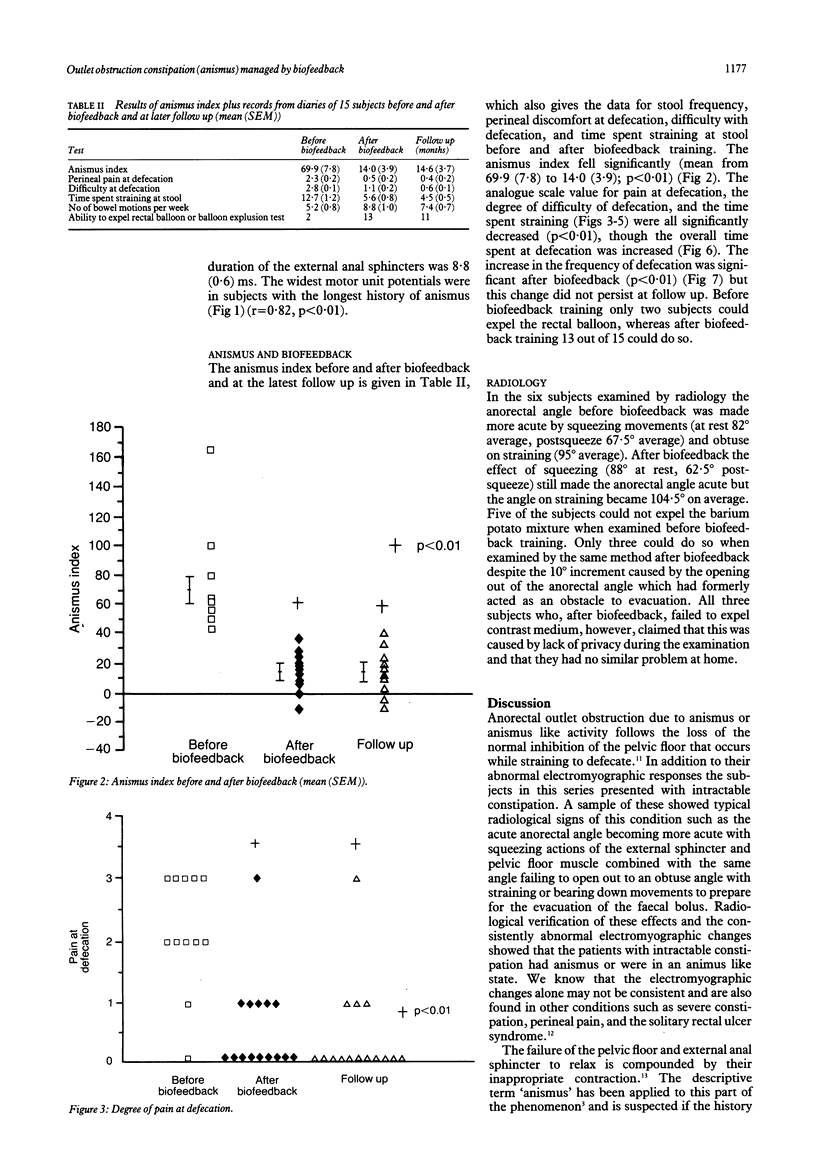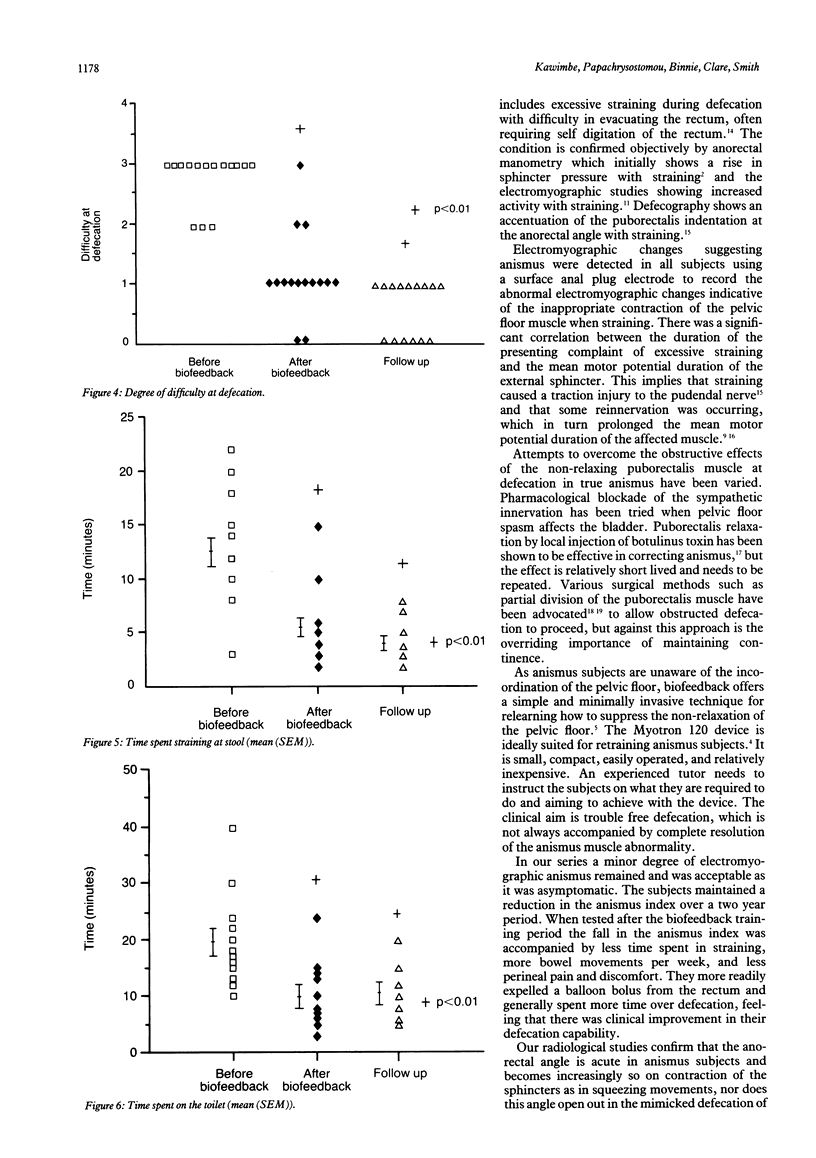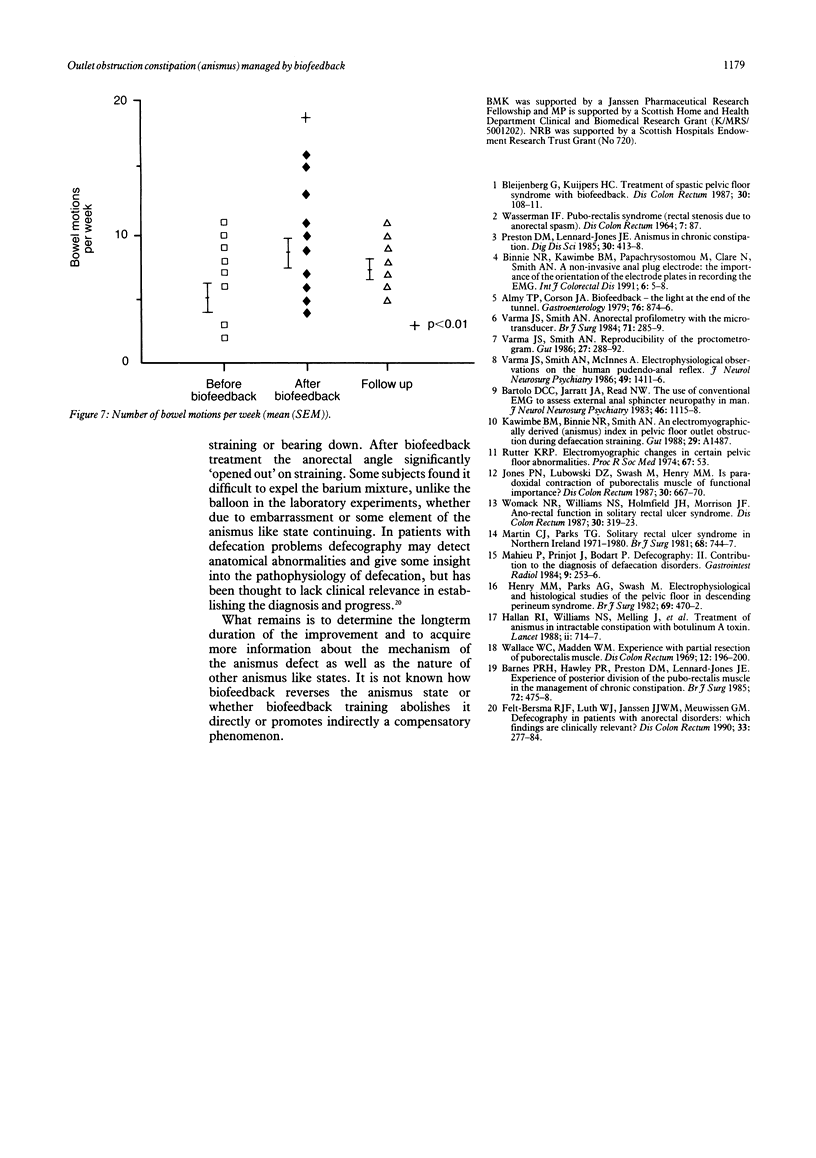Abstract
Fifteen subjects presenting with intractable constipation due to obstructive defecation, mean (SEM) duration 8.8 (1.8) years, had the inappropriate contraction and electromyographic changes in the pelvic floor muscles and external and sphincter typical of this condition. An electromyographically derived index was used to grade its severity. A self applied biofeedback device was used to allow electromyographic recording of the abnormal external anal sphincter. The subjects were encouraged to reduce the abnormal electromyographic activity on straining after instruction and training. The procedure was intended as a relearning process in which the non-relaxing activity of the pelvic floor was gradually suppressed. Biofeedback training was maintained on a domiciliary basis for a mean time of 3.1 weeks and resulted in a significant reduction in the anismus index (mean (SEM) 69.9 (7.8)% before biofeedback, mean 14 (3.9)% after biofeedback, p less than 0.01). There was an associated reduction in the time spent straining at stool and in the difficulty of defecation and an increased frequency of defecation. Defecatory video proctograms in six subjects showed improvements in the anorectal angle during straining and evacuation. The clinical benefit to the patients persisted after a mean follow up of 6.2 months.
Full text
PDF




Selected References
These references are in PubMed. This may not be the complete list of references from this article.
- Almy T. P., Corson J. A. Biofeedback--the light at the end of the tunnel? Gastroenterology. 1979 Apr;76(4):874–876. [PubMed] [Google Scholar]
- Barnes P. R., Hawley P. R., Preston D. M., Lennard-Jones J. E. Experience of posterior division of the puborectalis muscle in the management of chronic constipation. Br J Surg. 1985 Jun;72(6):475–477. doi: 10.1002/bjs.1800720623. [DOI] [PubMed] [Google Scholar]
- Bartolo D. C., Jarratt J. A., Read N. W. The use of conventional electromyography to assess external sphincter neuropathy in man. J Neurol Neurosurg Psychiatry. 1983 Dec;46(12):1115–1118. doi: 10.1136/jnnp.46.12.1115. [DOI] [PMC free article] [PubMed] [Google Scholar]
- Binnie N. R., Kawimbe B. M., Papachrysostomou M., Clare N., Smith A. N. The importance of the orientation of the electrode plates in recording the external anal sphincter EMG by non-invasive anal plug electrodes. Int J Colorectal Dis. 1991 Feb;6(1):5–8. doi: 10.1007/BF00703952. [DOI] [PubMed] [Google Scholar]
- Bleijenberg G., Kuijpers H. C. Treatment of the spastic pelvic floor syndrome with biofeedback. Dis Colon Rectum. 1987 Feb;30(2):108–111. doi: 10.1007/BF02554946. [DOI] [PubMed] [Google Scholar]
- Felt-Bersma R. J., Luth W. J., Janssen J. J., Meuwissen S. G. Defecography in patients with anorectal disorders. Which findings are clinically relevant? Dis Colon Rectum. 1990 Apr;33(4):277–284. doi: 10.1007/BF02055468. [DOI] [PubMed] [Google Scholar]
- Hallan R. I., Williams N. S., Melling J., Waldron D. J., Womack N. R., Morrison J. F. Treatment of anismus in intractable constipation with botulinum A toxin. Lancet. 1988 Sep 24;2(8613):714–717. doi: 10.1016/s0140-6736(88)90188-2. [DOI] [PubMed] [Google Scholar]
- Henry M. M., Parks A. G., Swash M. The pelvic floor musculature in the descending perineum syndrome. Br J Surg. 1982 Aug;69(8):470–472. doi: 10.1002/bjs.1800690813. [DOI] [PubMed] [Google Scholar]
- Jones P. N., Lubowski D. Z., Swash M., Henry M. M. Is paradoxical contraction of puborectalis muscle of functional importance? Dis Colon Rectum. 1987 Sep;30(9):667–670. doi: 10.1007/BF02561685. [DOI] [PubMed] [Google Scholar]
- Mahieu P., Pringot J., Bodart P. Defecography: II. Contribution to the diagnosis of defecation disorders. Gastrointest Radiol. 1984;9(3):253–261. doi: 10.1007/BF01887846. [DOI] [PubMed] [Google Scholar]
- Martin C. J., Parks T. G., Biggart J. D. Solitary rectal ulcer syndrome in Northern Ireland. 1971-1980. Br J Surg. 1981 Oct;68(10):744–747. doi: 10.1002/bjs.1800681021. [DOI] [PubMed] [Google Scholar]
- Preston D. M., Lennard-Jones J. E. Anismus in chronic constipation. Dig Dis Sci. 1985 May;30(5):413–418. doi: 10.1007/BF01318172. [DOI] [PubMed] [Google Scholar]
- Rutter K. R. Electromyographic changes in certain pelvic floor abnormalities. Proc R Soc Med. 1974 Jan;67(1):53–56. [PMC free article] [PubMed] [Google Scholar]
- Varma J. S., Smith A. N., McInnes A. Electrophysiological observations on the human pudendo-anal reflex. J Neurol Neurosurg Psychiatry. 1986 Dec;49(12):1411–1416. doi: 10.1136/jnnp.49.12.1411. [DOI] [PMC free article] [PubMed] [Google Scholar]
- Varma J. S., Smith A. N. Reproducibility of the proctometrogram. Gut. 1986 Mar;27(3):288–292. doi: 10.1136/gut.27.3.288. [DOI] [PMC free article] [PubMed] [Google Scholar]
- WASSERMAN I. F. PUBORECTALIS SYNDROME (RECTAL STENOSIS DUE TO ANORECTAL SPASM). Dis Colon Rectum. 1964 Mar-Apr;7:87–98. doi: 10.1007/BF02616902. [DOI] [PubMed] [Google Scholar]
- Wallace W. C., Madden W. M. Experience with partial resection of the puborectalis muscle. Dis Colon Rectum. 1969 May-Jun;12(3):196–200. doi: 10.1007/BF02617812. [DOI] [PubMed] [Google Scholar]
- Womack N. R., Williams N. S., Mist J. H., Morrison J. F. Anorectal function in the solitary rectal ulcer syndrome. Dis Colon Rectum. 1987 May;30(5):319–323. doi: 10.1007/BF02555447. [DOI] [PubMed] [Google Scholar]


